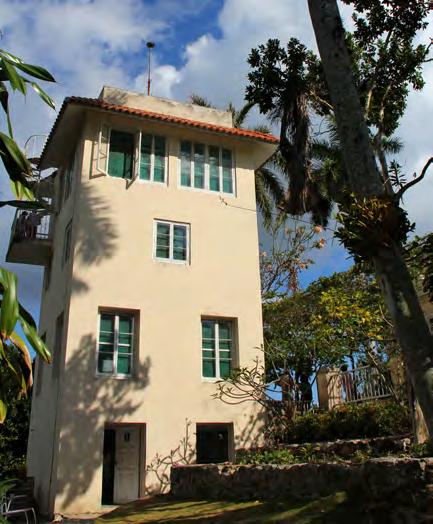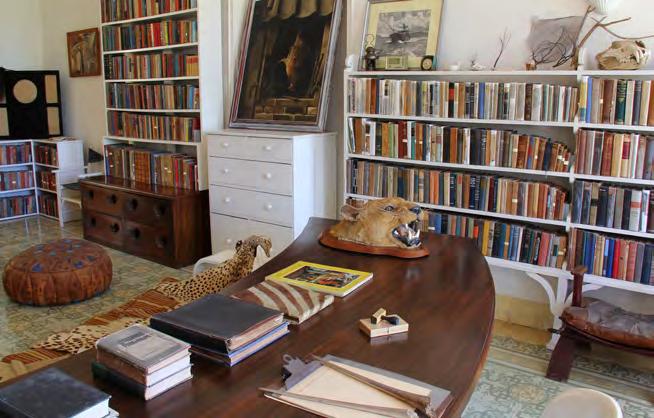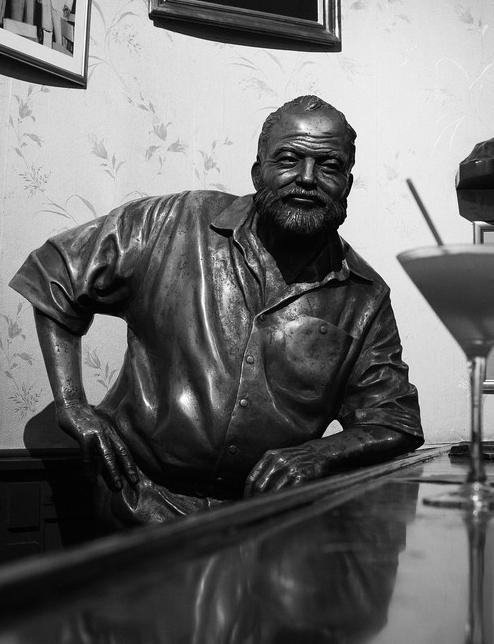
8 minute read
CALIDOSCOPIO
«
HEMINGWAY Y CUBA»
La primera vez que Hemingway visitó La Habana fue algo eventual. Estaba por cumplir 29 años y el vapor inglés en el que viajaba con su esposa Pauline Pfeiffer, con destino a Key West, hizo una breve escala en el puerto de La Habana. Comenzaba la primavera del año 1928, era primero de abril -hace justamente 94 años-. La estancia fue efímera y en medio de sus deseos por llegar al puerto de destino, nunca imaginó que esta isla le atraparía el alma. Un año después, su pasión por la pesca en mar abierto lo llevó hasta aguas cubanas para capturar peces de gran porte que abundan en mares tropicales, especialmente en la corriente del golfo. Y así, como cuando el mar acaricia la orilla de una playa y se integra, de a poco a la arena que humedece, Ernest Hemingway se enamoró de este archipiélago. Desde entonces, la isla grande de Cuba, algunos espacios de La Habana y varios de sus cayos, fueron para el escritor constantes inspiraciones, por lo que muchos quedaron cautivos en sus novelas. Aquel hombre, que una vez se autodefinió como un cubano común, vivió aquí por más de 20 años. Sea usted bienvenido a recorrer la sugestiva ruta que vincula al Premio Nobel de Literatura 1954, con algunos lugares en Cuba.
Hemingway and Cuba
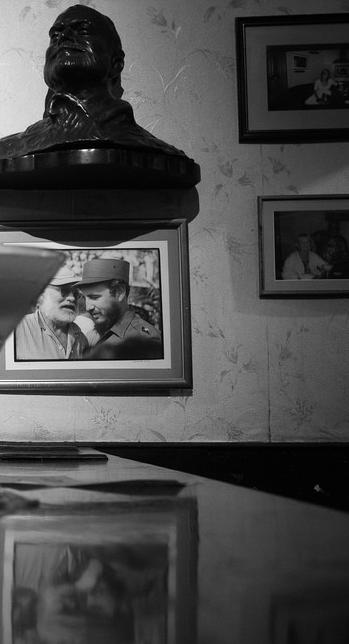
Hemingway's first visit to Havana was a casual one. He was about to turn 29 and the English steamer on which he was traveling with his wife Pauline Pfeiffer, bound for Key West, made a brief stopover in the port of Havana. It was the beginning of spring 1928, the first of April -just 94 years ago. The stay was short-lived and in the midst of his desire to reach the port of destination, he never imagined that this island would capture his soul. A year later, his passion for open sea fishing took him to Cuban waters to catch large fish that abound in tropical seas, especially in the Gulf Stream. And so, as when the sea caresses the shore of a beach and integrates itself, little by little, to the sand it moistens, Ernest Hemingway fell in love with this archipelago. Since then, the big island of Cuba, some areas of Havana and several of its keys, were constant inspirations for the writer, so many were captive in his novels. The man, who once described himself as an ordinary Cuban, lived here for more than 20 years. You are welcome to travel the suggestive route that links the 1954 Nobel Prize in Literature with some places in Cuba.
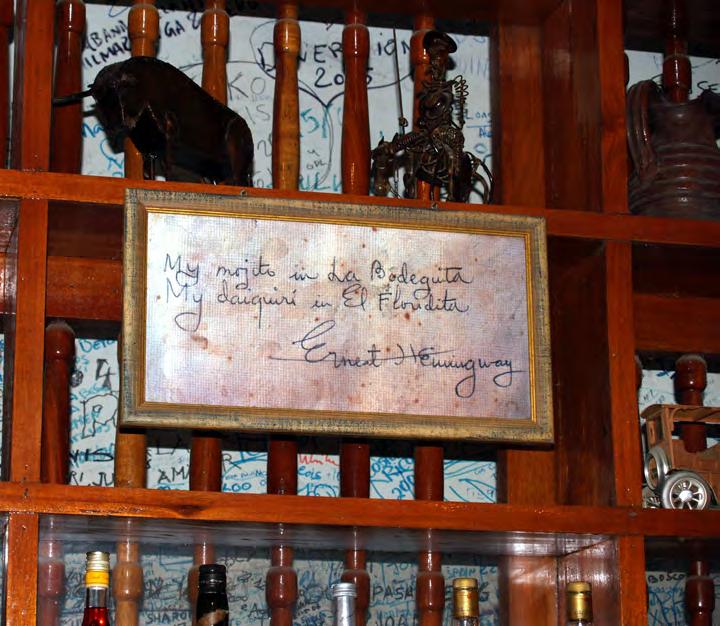
Vida bohemia
En su primera etapa en la isla vivió en el hotel Ambos Mundos, ubicado en La Habana Vieja. Su habitación, la 511 del acogedor establecimiento, aun se conserva tal cual la dejó el famoso escritor y constantemente, es visitada por cubanos y extranjeros que sienten curiosidad por acercarse a un espacio netamente hemingwayano. Su estancia en la capital cubana fue muy activa y uno de los sitios que quedó prendido a su vida, para siempre, fue el Floridita. Allí hizo amigos y también creó un trago con su nombre, el Papa Doble o Hemingway Special, una variante del Daiquirí, que se prepara a base de ron blanco cubano, limón, hierba buena y azúcar. En su versión, el novelista eliminó el azúcar y aumentó la porción de ron, con el fin de hacerlo más fuerte. El Daiquirí, el Papa Doble y la leyenda viven en el Floridita junto a su escultura en bronce, recostada de la barra, con su Daiquirí siempre recién preparado. Es por ello que este es un lugar muy especial para brindar en La Habana y muchos lo hacen, incluso, a su memoria.
Bohemian life
During his first period on the island, he lived in the Ambos Mundos Hotel, located in Old Havana. His room, number 511 of the charming establishment, is still preserved just as the famous writer left it and is constantly visited by Cubans and foreigners who are curious to get closer to a purely Hemingwayian space. His stay in the Cuban capital was very active and one of the places that remained in his life forever was the Floridita. There he made friends and also created a drink with his name, the Papa Doble or Hemingway Special, a variant of the Daiquiri, which is prepared with Cuban white rum, lemon, mint and sugar. In his version, the novelist eliminated the sugar and increased the portion of rum, in order to make it stronger. The Daiquiri, the Papa Doble and the legend live in the Floridita next to its bronze sculpture, leaning against the bar, with its Daiquiri always freshly prepared. That is why this is a very special place to toast in Havana and many do so, even in his memory.
El mar de Cuba en Hemingway
Atravesando el túnel de la Ciudad Maravilla, a tan solo veinte minutos en auto, está Cojímar, un pequeño y antiguo poblado de pescadores vinculado a una de las más conocidas novelas del famoso escritor: El viejo y el mar. En Cojímar, atracaba su yate Pilar y allí compartía con los marineros de la zona, fue así que conoció a Gregorio Fuentes, quien fuera el timonel de su yate hasta que se marchara definitivamente de Cuba. En este lugar, cercano al mar, está ubicado el restaurante bar La Terraza, especializado en mariscos y pescados, donde tantas veces disfrutó de encuentros, comidas y agradables veladas. Otro de los sitios que hizo sucumbir al autor de “Islas en el Golfo”, fue la cayería norte del centro de la isla. Los cayos Coco, Guillermo y Romano, fueron para él un paraíso en la tierra, sus bondades naturales y la belleza de su entorno le calaron hondo. Actualmente, estos extraordinarios islotes se han convertido en uno de los destinos de sol y playa más concurridos de la isla antillana. Su afinidad por el mar lo llevó a visitar asiduamente, la dársena de Barlovento, al oeste de la capital, lugar que acoge desde hace décadas, a la marina más importante del país: Marina Hemingway, reconocida mundialmente por ser sede de notorios eventos de pesca y, además, un puerto libre y seguro en el Caribe, donde atracar, permanecer y poder avituallarse. En esta marina se organiza, con mucho éxito, desde 1950, el Torneo Internacional de la Pesca de la Aguja “Ernest Hemingway”.

The sea of Cuba in Hemingway
Crossing the tunnel of the Wonder City, just twenty minutes away by car, is Cojímar, a small and old fishing village linked to one of the most famous novels of the famous writer: The Old Man and the Sea. In Cojímar, he moored his yacht Pilar and there he shared with the sailors of the area, that is how he met Gregorio Fuentes, who was the helmsman of his yacht until he left Cuba definitively. In this place, close to the sea, is located the restaurant bar La Terraza, specialized in seafood and fish, where so many times he enjoyed gatherings, meals and pleasant evenings. Another place that made the author of "Islands in the Gulf" succumb was the northern keys in the center of the island. Coco, Guillermo and Romano keys were for him a paradise on earth, their natural goodness and the beauty of their environment touched him deeply. Currently, these extraordinary islets have become one of the most popular sun and beach destinations in the Antillean island. His affinity for the sea led him to visit assiduously the Barlovento dock, west of the capital, a place that for decades has been home to the most important marina in the country: Marina Hemingway, recognized worldwide for hosting notorious fishing events and, in addition, a free and safe port in the Caribbean, where to dock, stay and stock up. The "Ernest Hemingway" International Marlin Fishing Tournament has been successfully organized in this marina since 1950.
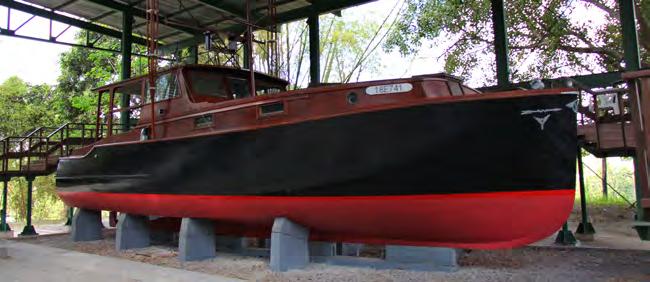
Finca Vigía
Fue la residencia permanente de Ernest Hemingway en La Habana. En ella vivió hasta 1960 y allí escribió muchas de sus más conocidas obras. Ubicada en una colina de San Francisco de Paula, en la periferia habanera, esta hermosa casa, llena de leyendas y valiosos recuerdos, es uno de los museos más visitados de la ciudad. Sin lugar a dudas, Hemingway marcó lugares asombrosos en la mayor de las Antillas. Hoy en día, todos estos sitios que de alguna manera convergieron con su vida, son ideales para hacer turismo pues, tienen ese toque mágico que enamoran al viajero ávido de aventura, historia y satisfacción.
Finca Vigía
It was Ernest Hemingway's permanent residence in Havana. He lived there until 1960 and wrote many of his best-known works there. Located on a hill in San Francisco de Paula, on the outskirts of Havana, this beautiful house, full of legends and valuable memories, is one of the most visited museums in the city. Undoubtedly, Hemingway marked amazing places in the largest Antillean Island. Today, all these places that somehow converged with his life, are ideal for tourism because they have that magical touch that enamors the traveler eager for adventure, history and satisfaction.
